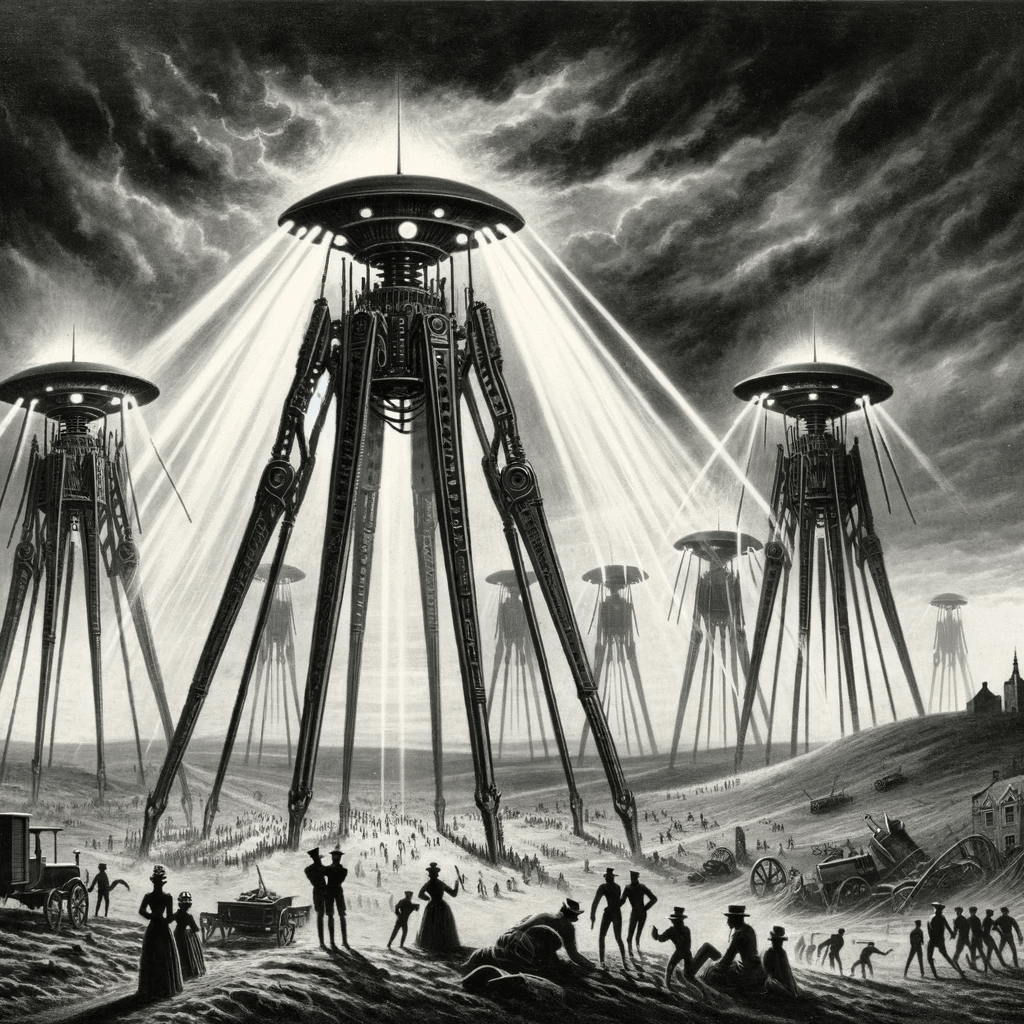War of the Worlds (1898)

“War of the Worlds” is a science fiction novel written by H.G. Wells and first published in 1898. The novel tells the story of a Martian invasion of Earth and the struggles of humanity to survive in the face of overwhelming technological superiority. The book has been highly influential in the science fiction genre and has inspired numerous adaptations and interpretations in various media.
The key claim made in “War of the Worlds” is that advanced extraterrestrial life exists and that it is capable of devastating humanity with its superior technology. The novel’s narrative is driven by the clash between the Martians, who have developed advanced technology such as heat rays and flying machines, and the human beings who are struggling to survive against the alien invaders.
In H.G. Wells’ “War of the Worlds” novel, the Martian spacecraft are described as large, tripod-like machines with a rounded central body that contains the Martians themselves. The central body is described as being “like a great metallic spider” and is supported by three spindly legs, which allow the machines to move around with great speed and agility.
The rounded central body of the Martian machines is often described as being somewhat spherical in shape, but it is not a perfect sphere. It is more accurately described as a rounded, metallic body that contains various mechanisms and instruments that the Martians use to operate the machines.
The book’s narrative also explores themes of imperialism, colonialism, and the dangers of unchecked scientific progress. Wells uses the Martian invasion as a metaphor for the violent and destructive effects of colonialism, and he argues that the unchecked pursuit of scientific progress can lead to catastrophic consequences.
One of the key figures in the book is the unnamed narrator, who serves as the protagonist and point-of-view character for the story. The narrator is a writer and journalist who is caught up in the chaos and destruction caused by the Martian invasion. His experiences and observations provide insight into the impact of the invasion on humanity and the challenges faced by those trying to survive.
The Martians themselves are depicted as intelligent, but emotionless beings who are driven solely by their desire to conquer and dominate. They are depicted as having developed advanced technology, such as heat rays and flying machines, that allow them to easily destroy and overcome human resistance.
In addition to its influence on the science fiction genre, “War of the Worlds” has also been the subject of much literary analysis and interpretation. Some critics have read the book as a critique of imperialism and the dangers of unchecked scientific progress, while others have seen it as a warning about the potential consequences of technological advancement.
There have also been several adaptations and reinterpretations of “War of the Worlds” in various media. One of the most notable is the 1938 radio broadcast by Orson Welles, which famously caused widespread panic and hysteria among listeners who believed that a real Martian invasion was taking place.
This captivating event, known as “The War of the Worlds” broadcast, was a dramatized adaptation of H.G. Wells’ science fiction novel of the same name, and aired on October 30, 1938, as part of the Mercury Theatre on the Air radio series.
Welles’ ingenious use of realistic news bulletins and sound effects throughout the program, combined with the fact that many listeners tuned in late and missed the introduction stating that it was a fictional drama, led to a significant portion of the audience interpreting the broadcast as genuine news. The power of radio as a medium for conveying information at that time, coupled with the tense political climate and fears of war, further fueled the listeners’ susceptibility to panic.
The ensuing chaos saw people fleeing their homes, calling the police, and even seeking refuge in churches, while telephone lines were jammed with frantic inquiries. The widespread confusion and hysteria that followed the broadcast led to significant media coverage and public debate about the responsibility of broadcasters and the potential consequences of spreading misinformation.
Another notable adaptation is the 2005 film directed by Steven Spielberg and starring Tom Cruise, which updates the story to the modern day and explores themes of family and survival in the face of overwhelming adversity.
“War of the Worlds” is a classic science fiction novel that explores themes of imperialism, scientific progress, and the potential dangers of extraterrestrial life.

